Hand Hygiene: Qualitative and Quantitative Studies
VerifiedAdded on 2022/11/18
|8
|2009
|261
AI Summary
The article discusses the qualitative and quantitative studies on hand hygiene protocol and ways to maintain it. It covers the background, method of studies, result of studies, ethical consideration, outcome comparison, and conclusion. The studies suggest that hand hygiene is the most priority care that should be taken by every healthcare professional to reduce the level of infection in healthcare units and improve the health of patients. The article recommends that every healthcare sector must follow the protocol for washing hands by communicating the concern to every health department by the means of posters and presentation.
Contribute Materials
Your contribution can guide someone’s learning journey. Share your
documents today.
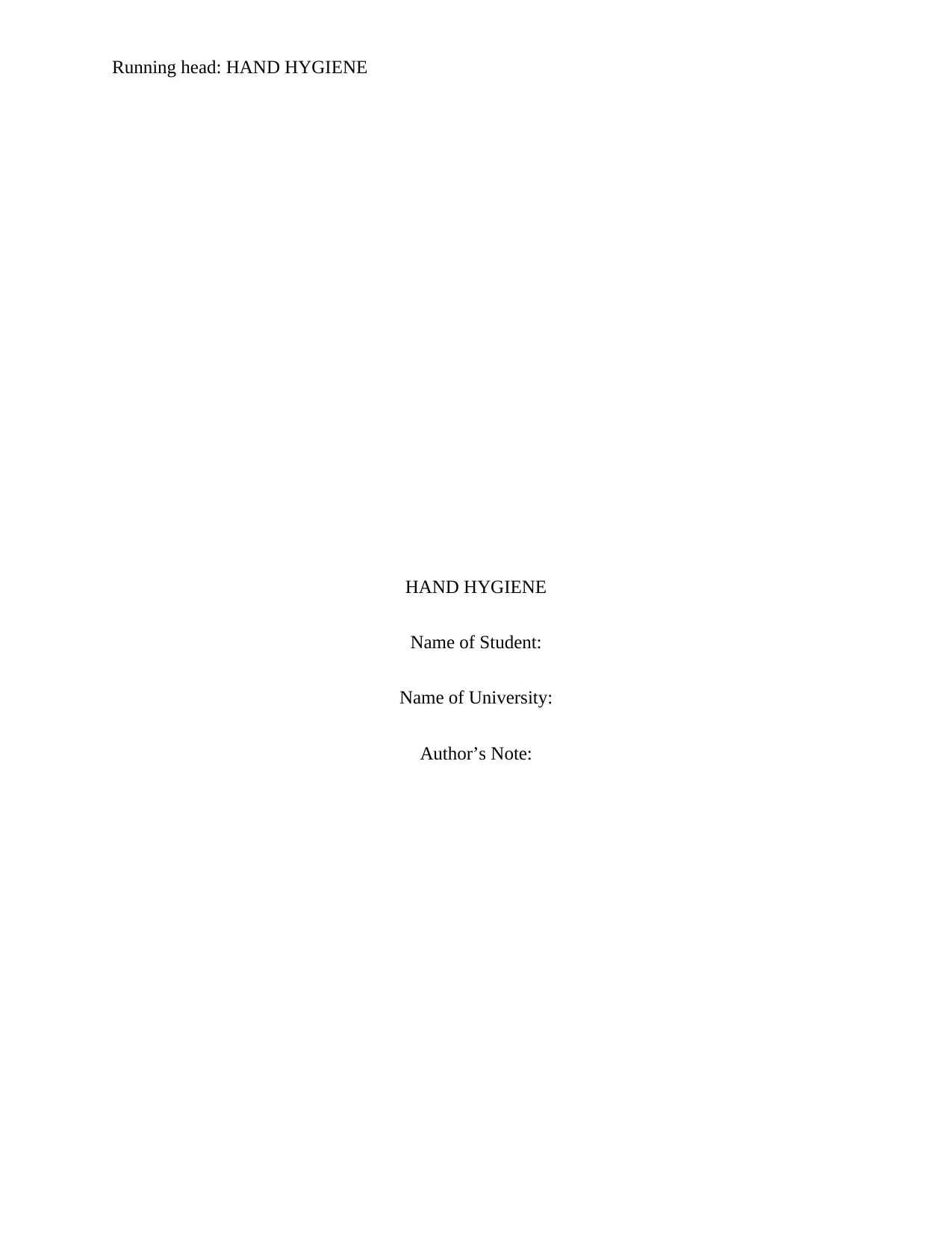
Running head: HAND HYGIENE
HAND HYGIENE
Name of Student:
Name of University:
Author’s Note:
HAND HYGIENE
Name of Student:
Name of University:
Author’s Note:
Secure Best Marks with AI Grader
Need help grading? Try our AI Grader for instant feedback on your assignments.
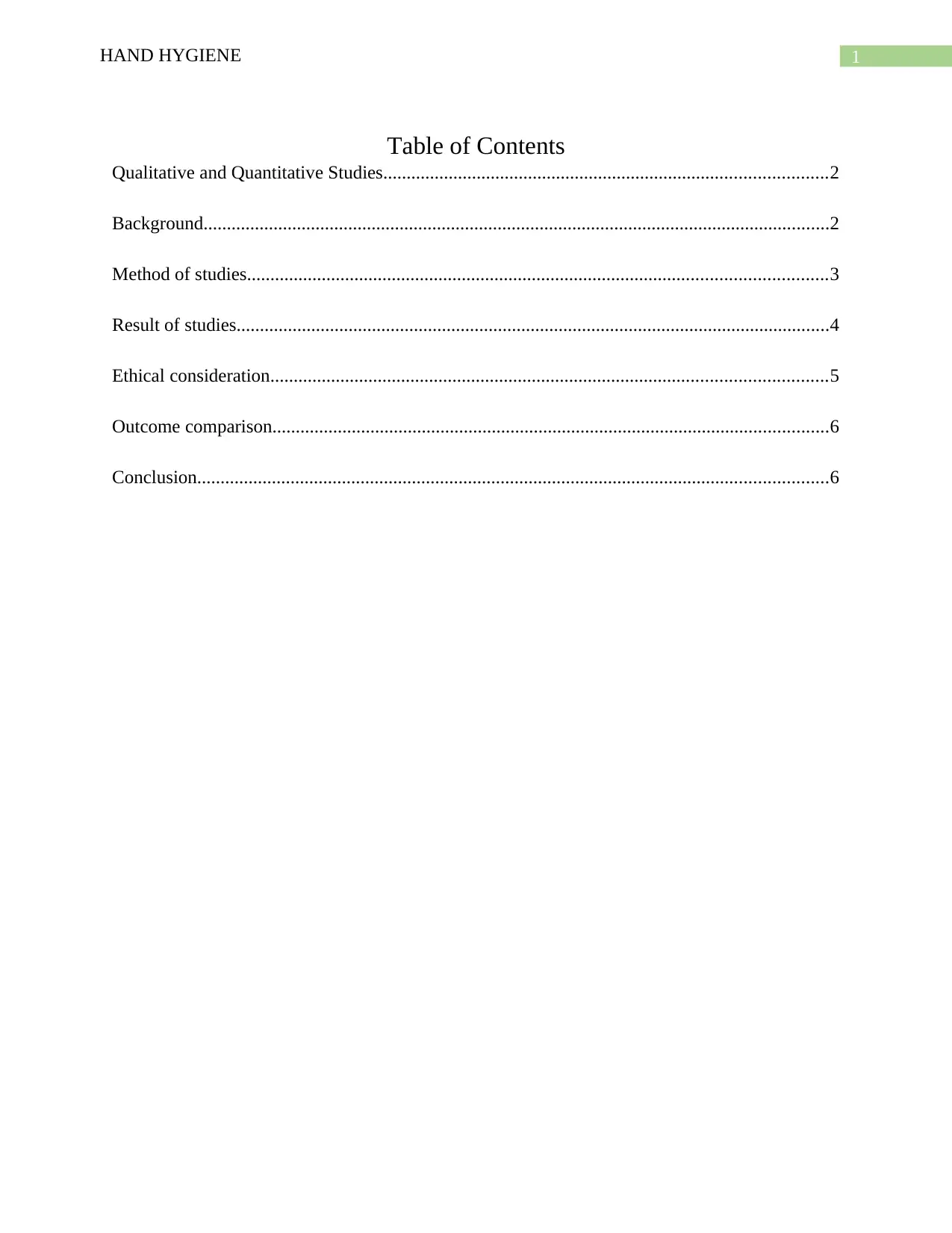
1HAND HYGIENE
Table of Contents
Qualitative and Quantitative Studies...............................................................................................2
Background......................................................................................................................................2
Method of studies............................................................................................................................3
Result of studies...............................................................................................................................4
Ethical consideration.......................................................................................................................5
Outcome comparison.......................................................................................................................6
Conclusion.......................................................................................................................................6
Table of Contents
Qualitative and Quantitative Studies...............................................................................................2
Background......................................................................................................................................2
Method of studies............................................................................................................................3
Result of studies...............................................................................................................................4
Ethical consideration.......................................................................................................................5
Outcome comparison.......................................................................................................................6
Conclusion.......................................................................................................................................6
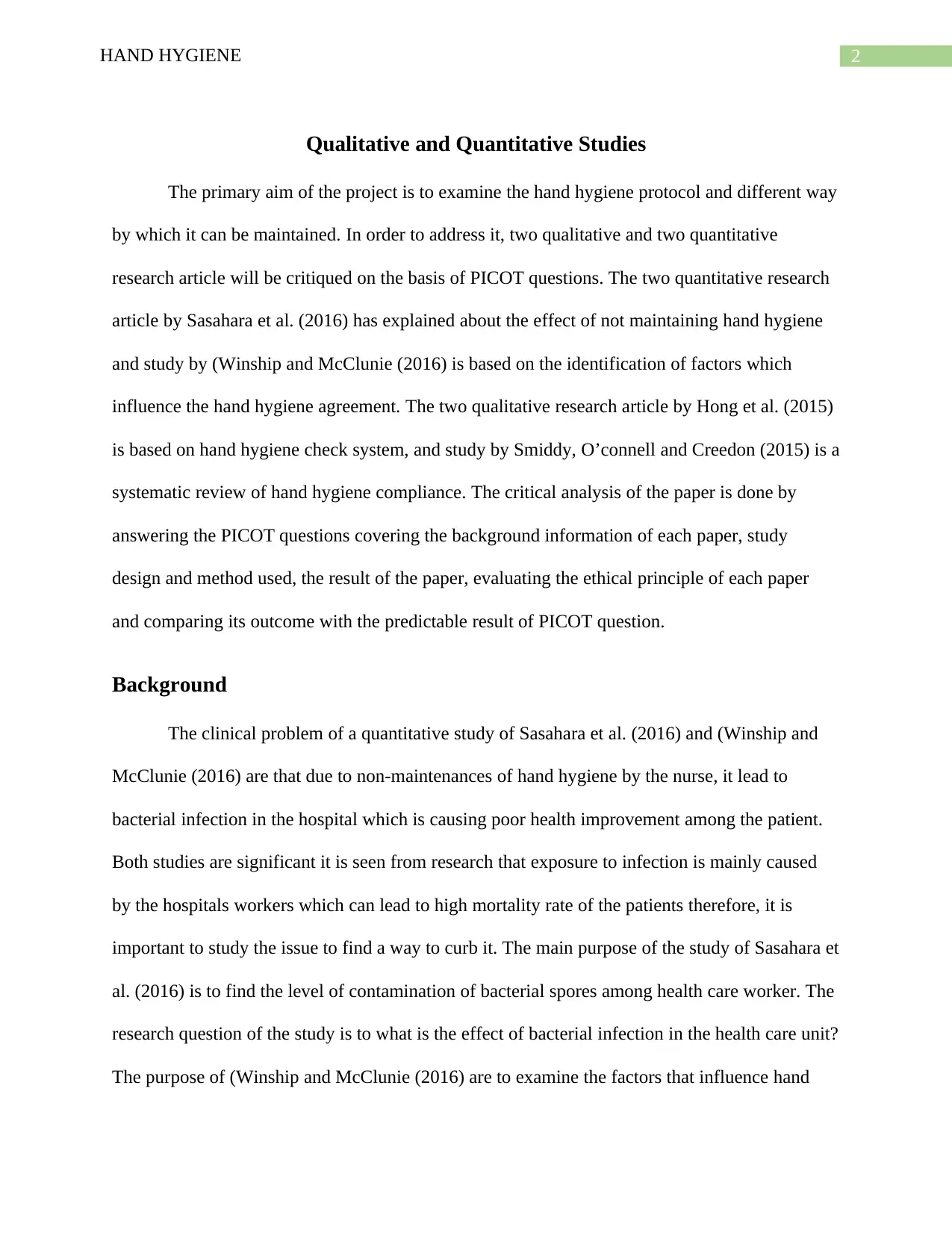
2HAND HYGIENE
Qualitative and Quantitative Studies
The primary aim of the project is to examine the hand hygiene protocol and different way
by which it can be maintained. In order to address it, two qualitative and two quantitative
research article will be critiqued on the basis of PICOT questions. The two quantitative research
article by Sasahara et al. (2016) has explained about the effect of not maintaining hand hygiene
and study by (Winship and McClunie (2016) is based on the identification of factors which
influence the hand hygiene agreement. The two qualitative research article by Hong et al. (2015)
is based on hand hygiene check system, and study by Smiddy, O’connell and Creedon (2015) is a
systematic review of hand hygiene compliance. The critical analysis of the paper is done by
answering the PICOT questions covering the background information of each paper, study
design and method used, the result of the paper, evaluating the ethical principle of each paper
and comparing its outcome with the predictable result of PICOT question.
Background
The clinical problem of a quantitative study of Sasahara et al. (2016) and (Winship and
McClunie (2016) are that due to non-maintenances of hand hygiene by the nurse, it lead to
bacterial infection in the hospital which is causing poor health improvement among the patient.
Both studies are significant it is seen from research that exposure to infection is mainly caused
by the hospitals workers which can lead to high mortality rate of the patients therefore, it is
important to study the issue to find a way to curb it. The main purpose of the study of Sasahara et
al. (2016) is to find the level of contamination of bacterial spores among health care worker. The
research question of the study is to what is the effect of bacterial infection in the health care unit?
The purpose of (Winship and McClunie (2016) are to examine the factors that influence hand
Qualitative and Quantitative Studies
The primary aim of the project is to examine the hand hygiene protocol and different way
by which it can be maintained. In order to address it, two qualitative and two quantitative
research article will be critiqued on the basis of PICOT questions. The two quantitative research
article by Sasahara et al. (2016) has explained about the effect of not maintaining hand hygiene
and study by (Winship and McClunie (2016) is based on the identification of factors which
influence the hand hygiene agreement. The two qualitative research article by Hong et al. (2015)
is based on hand hygiene check system, and study by Smiddy, O’connell and Creedon (2015) is a
systematic review of hand hygiene compliance. The critical analysis of the paper is done by
answering the PICOT questions covering the background information of each paper, study
design and method used, the result of the paper, evaluating the ethical principle of each paper
and comparing its outcome with the predictable result of PICOT question.
Background
The clinical problem of a quantitative study of Sasahara et al. (2016) and (Winship and
McClunie (2016) are that due to non-maintenances of hand hygiene by the nurse, it lead to
bacterial infection in the hospital which is causing poor health improvement among the patient.
Both studies are significant it is seen from research that exposure to infection is mainly caused
by the hospitals workers which can lead to high mortality rate of the patients therefore, it is
important to study the issue to find a way to curb it. The main purpose of the study of Sasahara et
al. (2016) is to find the level of contamination of bacterial spores among health care worker. The
research question of the study is to what is the effect of bacterial infection in the health care unit?
The purpose of (Winship and McClunie (2016) are to examine the factors that influence hand
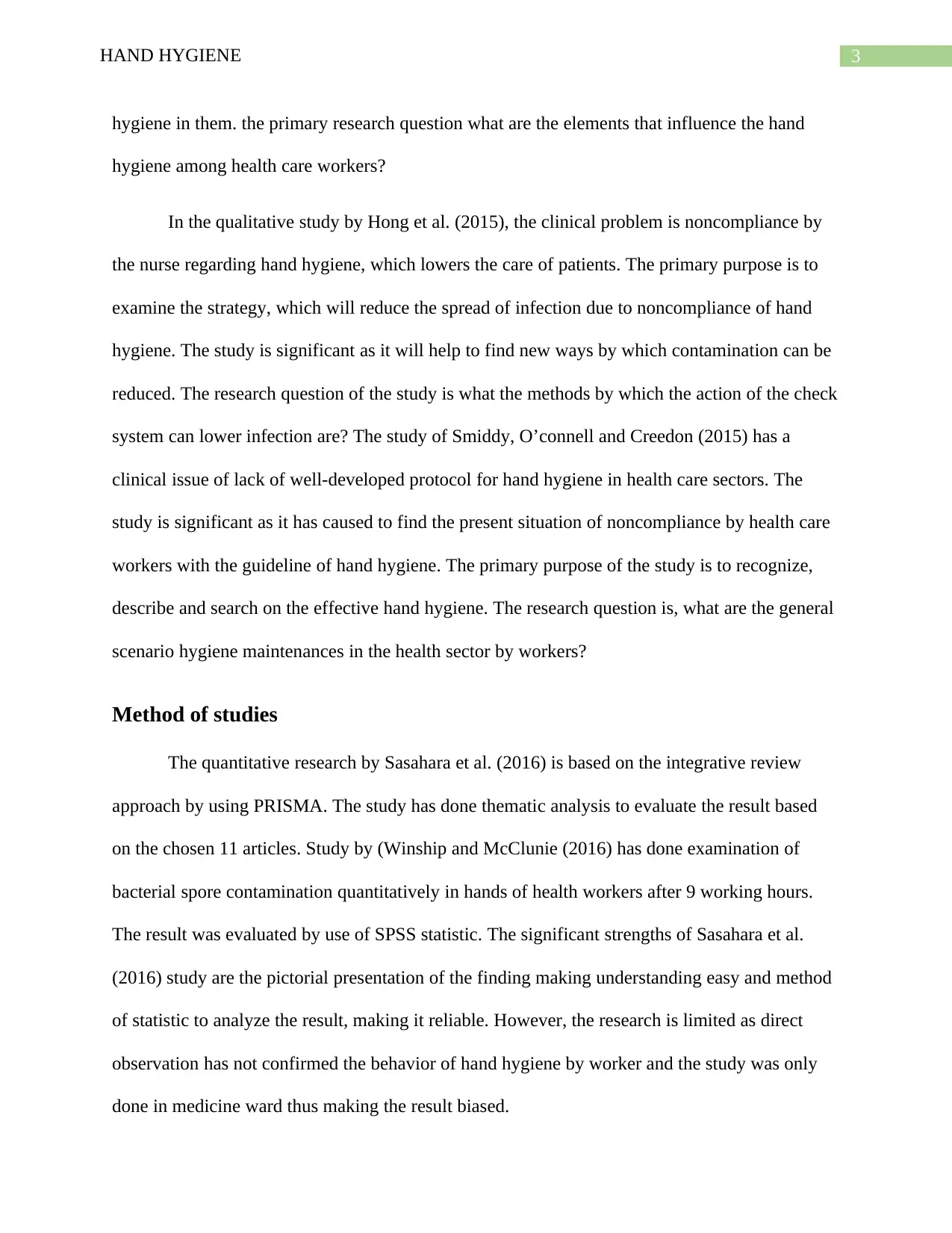
3HAND HYGIENE
hygiene in them. the primary research question what are the elements that influence the hand
hygiene among health care workers?
In the qualitative study by Hong et al. (2015), the clinical problem is noncompliance by
the nurse regarding hand hygiene, which lowers the care of patients. The primary purpose is to
examine the strategy, which will reduce the spread of infection due to noncompliance of hand
hygiene. The study is significant as it will help to find new ways by which contamination can be
reduced. The research question of the study is what the methods by which the action of the check
system can lower infection are? The study of Smiddy, O’connell and Creedon (2015) has a
clinical issue of lack of well-developed protocol for hand hygiene in health care sectors. The
study is significant as it has caused to find the present situation of noncompliance by health care
workers with the guideline of hand hygiene. The primary purpose of the study is to recognize,
describe and search on the effective hand hygiene. The research question is, what are the general
scenario hygiene maintenances in the health sector by workers?
Method of studies
The quantitative research by Sasahara et al. (2016) is based on the integrative review
approach by using PRISMA. The study has done thematic analysis to evaluate the result based
on the chosen 11 articles. Study by (Winship and McClunie (2016) has done examination of
bacterial spore contamination quantitatively in hands of health workers after 9 working hours.
The result was evaluated by use of SPSS statistic. The significant strengths of Sasahara et al.
(2016) study are the pictorial presentation of the finding making understanding easy and method
of statistic to analyze the result, making it reliable. However, the research is limited as direct
observation has not confirmed the behavior of hand hygiene by worker and the study was only
done in medicine ward thus making the result biased.
hygiene in them. the primary research question what are the elements that influence the hand
hygiene among health care workers?
In the qualitative study by Hong et al. (2015), the clinical problem is noncompliance by
the nurse regarding hand hygiene, which lowers the care of patients. The primary purpose is to
examine the strategy, which will reduce the spread of infection due to noncompliance of hand
hygiene. The study is significant as it will help to find new ways by which contamination can be
reduced. The research question of the study is what the methods by which the action of the check
system can lower infection are? The study of Smiddy, O’connell and Creedon (2015) has a
clinical issue of lack of well-developed protocol for hand hygiene in health care sectors. The
study is significant as it has caused to find the present situation of noncompliance by health care
workers with the guideline of hand hygiene. The primary purpose of the study is to recognize,
describe and search on the effective hand hygiene. The research question is, what are the general
scenario hygiene maintenances in the health sector by workers?
Method of studies
The quantitative research by Sasahara et al. (2016) is based on the integrative review
approach by using PRISMA. The study has done thematic analysis to evaluate the result based
on the chosen 11 articles. Study by (Winship and McClunie (2016) has done examination of
bacterial spore contamination quantitatively in hands of health workers after 9 working hours.
The result was evaluated by use of SPSS statistic. The significant strengths of Sasahara et al.
(2016) study are the pictorial presentation of the finding making understanding easy and method
of statistic to analyze the result, making it reliable. However, the research is limited as direct
observation has not confirmed the behavior of hand hygiene by worker and the study was only
done in medicine ward thus making the result biased.
Secure Best Marks with AI Grader
Need help grading? Try our AI Grader for instant feedback on your assignments.
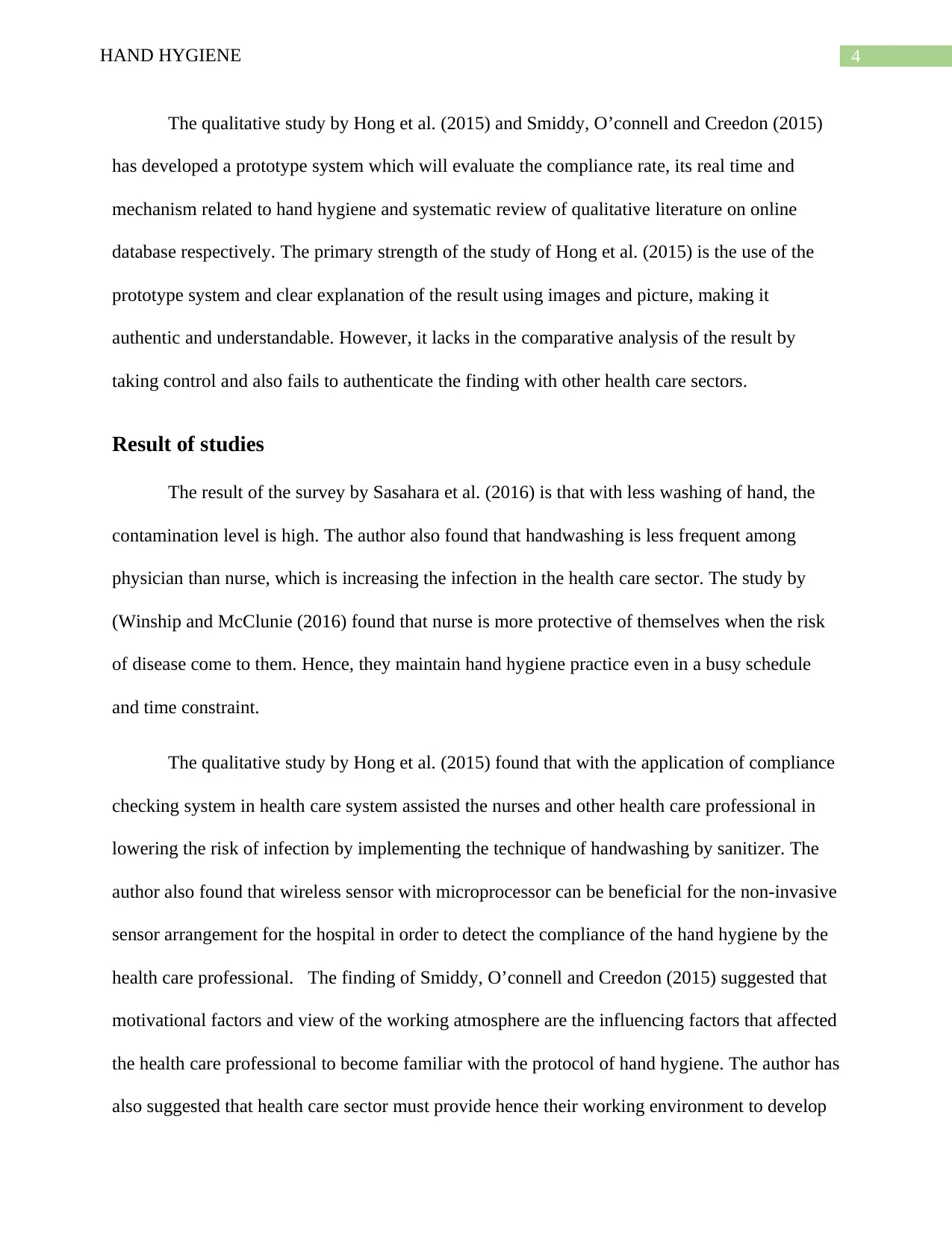
4HAND HYGIENE
The qualitative study by Hong et al. (2015) and Smiddy, O’connell and Creedon (2015)
has developed a prototype system which will evaluate the compliance rate, its real time and
mechanism related to hand hygiene and systematic review of qualitative literature on online
database respectively. The primary strength of the study of Hong et al. (2015) is the use of the
prototype system and clear explanation of the result using images and picture, making it
authentic and understandable. However, it lacks in the comparative analysis of the result by
taking control and also fails to authenticate the finding with other health care sectors.
Result of studies
The result of the survey by Sasahara et al. (2016) is that with less washing of hand, the
contamination level is high. The author also found that handwashing is less frequent among
physician than nurse, which is increasing the infection in the health care sector. The study by
(Winship and McClunie (2016) found that nurse is more protective of themselves when the risk
of disease come to them. Hence, they maintain hand hygiene practice even in a busy schedule
and time constraint.
The qualitative study by Hong et al. (2015) found that with the application of compliance
checking system in health care system assisted the nurses and other health care professional in
lowering the risk of infection by implementing the technique of handwashing by sanitizer. The
author also found that wireless sensor with microprocessor can be beneficial for the non-invasive
sensor arrangement for the hospital in order to detect the compliance of the hand hygiene by the
health care professional. The finding of Smiddy, O’connell and Creedon (2015) suggested that
motivational factors and view of the working atmosphere are the influencing factors that affected
the health care professional to become familiar with the protocol of hand hygiene. The author has
also suggested that health care sector must provide hence their working environment to develop
The qualitative study by Hong et al. (2015) and Smiddy, O’connell and Creedon (2015)
has developed a prototype system which will evaluate the compliance rate, its real time and
mechanism related to hand hygiene and systematic review of qualitative literature on online
database respectively. The primary strength of the study of Hong et al. (2015) is the use of the
prototype system and clear explanation of the result using images and picture, making it
authentic and understandable. However, it lacks in the comparative analysis of the result by
taking control and also fails to authenticate the finding with other health care sectors.
Result of studies
The result of the survey by Sasahara et al. (2016) is that with less washing of hand, the
contamination level is high. The author also found that handwashing is less frequent among
physician than nurse, which is increasing the infection in the health care sector. The study by
(Winship and McClunie (2016) found that nurse is more protective of themselves when the risk
of disease come to them. Hence, they maintain hand hygiene practice even in a busy schedule
and time constraint.
The qualitative study by Hong et al. (2015) found that with the application of compliance
checking system in health care system assisted the nurses and other health care professional in
lowering the risk of infection by implementing the technique of handwashing by sanitizer. The
author also found that wireless sensor with microprocessor can be beneficial for the non-invasive
sensor arrangement for the hospital in order to detect the compliance of the hand hygiene by the
health care professional. The finding of Smiddy, O’connell and Creedon (2015) suggested that
motivational factors and view of the working atmosphere are the influencing factors that affected
the health care professional to become familiar with the protocol of hand hygiene. The author has
also suggested that health care sector must provide hence their working environment to develop
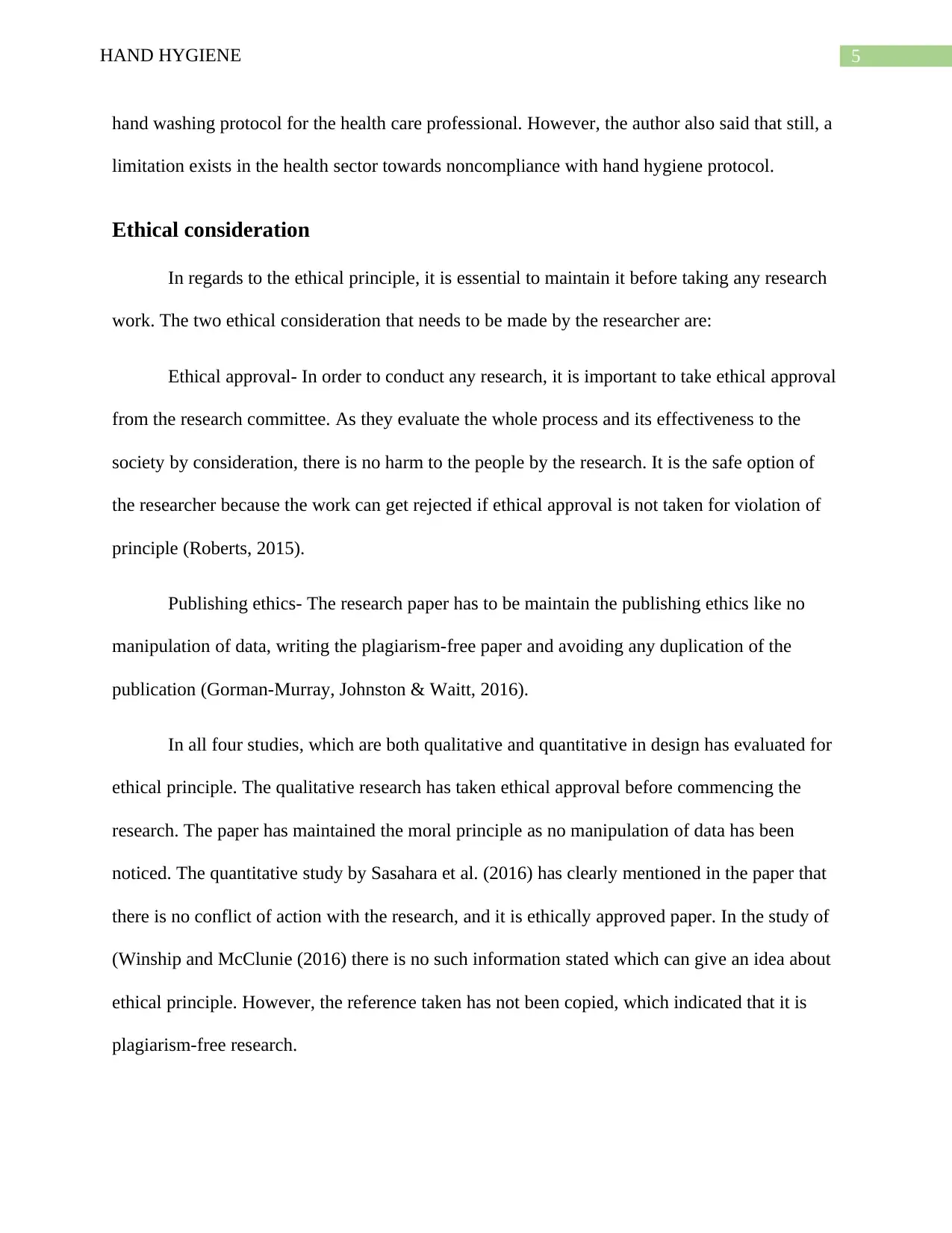
5HAND HYGIENE
hand washing protocol for the health care professional. However, the author also said that still, a
limitation exists in the health sector towards noncompliance with hand hygiene protocol.
Ethical consideration
In regards to the ethical principle, it is essential to maintain it before taking any research
work. The two ethical consideration that needs to be made by the researcher are:
Ethical approval- In order to conduct any research, it is important to take ethical approval
from the research committee. As they evaluate the whole process and its effectiveness to the
society by consideration, there is no harm to the people by the research. It is the safe option of
the researcher because the work can get rejected if ethical approval is not taken for violation of
principle (Roberts, 2015).
Publishing ethics- The research paper has to be maintain the publishing ethics like no
manipulation of data, writing the plagiarism-free paper and avoiding any duplication of the
publication (Gorman-Murray, Johnston & Waitt, 2016).
In all four studies, which are both qualitative and quantitative in design has evaluated for
ethical principle. The qualitative research has taken ethical approval before commencing the
research. The paper has maintained the moral principle as no manipulation of data has been
noticed. The quantitative study by Sasahara et al. (2016) has clearly mentioned in the paper that
there is no conflict of action with the research, and it is ethically approved paper. In the study of
(Winship and McClunie (2016) there is no such information stated which can give an idea about
ethical principle. However, the reference taken has not been copied, which indicated that it is
plagiarism-free research.
hand washing protocol for the health care professional. However, the author also said that still, a
limitation exists in the health sector towards noncompliance with hand hygiene protocol.
Ethical consideration
In regards to the ethical principle, it is essential to maintain it before taking any research
work. The two ethical consideration that needs to be made by the researcher are:
Ethical approval- In order to conduct any research, it is important to take ethical approval
from the research committee. As they evaluate the whole process and its effectiveness to the
society by consideration, there is no harm to the people by the research. It is the safe option of
the researcher because the work can get rejected if ethical approval is not taken for violation of
principle (Roberts, 2015).
Publishing ethics- The research paper has to be maintain the publishing ethics like no
manipulation of data, writing the plagiarism-free paper and avoiding any duplication of the
publication (Gorman-Murray, Johnston & Waitt, 2016).
In all four studies, which are both qualitative and quantitative in design has evaluated for
ethical principle. The qualitative research has taken ethical approval before commencing the
research. The paper has maintained the moral principle as no manipulation of data has been
noticed. The quantitative study by Sasahara et al. (2016) has clearly mentioned in the paper that
there is no conflict of action with the research, and it is ethically approved paper. In the study of
(Winship and McClunie (2016) there is no such information stated which can give an idea about
ethical principle. However, the reference taken has not been copied, which indicated that it is
plagiarism-free research.
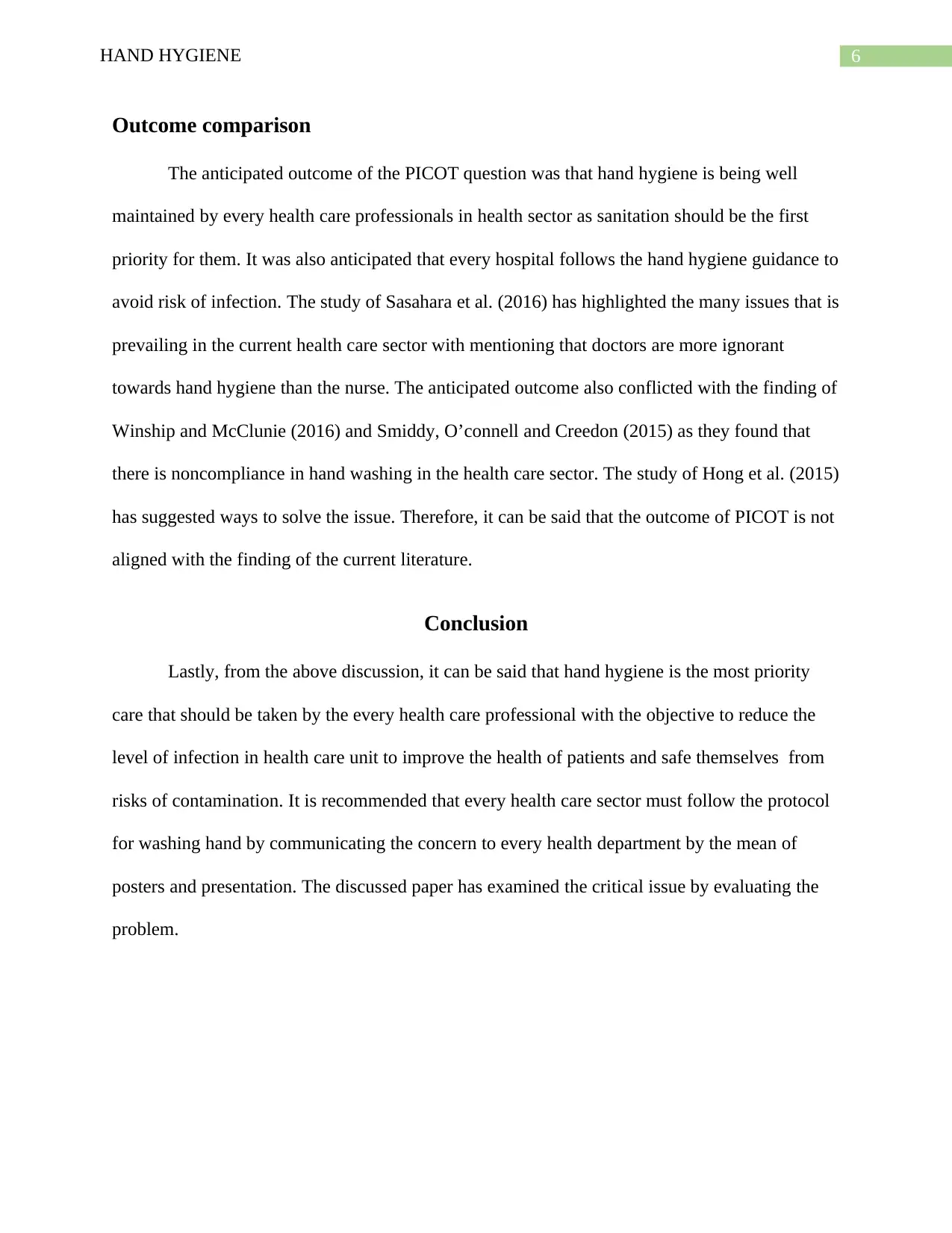
6HAND HYGIENE
Outcome comparison
The anticipated outcome of the PICOT question was that hand hygiene is being well
maintained by every health care professionals in health sector as sanitation should be the first
priority for them. It was also anticipated that every hospital follows the hand hygiene guidance to
avoid risk of infection. The study of Sasahara et al. (2016) has highlighted the many issues that is
prevailing in the current health care sector with mentioning that doctors are more ignorant
towards hand hygiene than the nurse. The anticipated outcome also conflicted with the finding of
Winship and McClunie (2016) and Smiddy, O’connell and Creedon (2015) as they found that
there is noncompliance in hand washing in the health care sector. The study of Hong et al. (2015)
has suggested ways to solve the issue. Therefore, it can be said that the outcome of PICOT is not
aligned with the finding of the current literature.
Conclusion
Lastly, from the above discussion, it can be said that hand hygiene is the most priority
care that should be taken by the every health care professional with the objective to reduce the
level of infection in health care unit to improve the health of patients and safe themselves from
risks of contamination. It is recommended that every health care sector must follow the protocol
for washing hand by communicating the concern to every health department by the mean of
posters and presentation. The discussed paper has examined the critical issue by evaluating the
problem.
Outcome comparison
The anticipated outcome of the PICOT question was that hand hygiene is being well
maintained by every health care professionals in health sector as sanitation should be the first
priority for them. It was also anticipated that every hospital follows the hand hygiene guidance to
avoid risk of infection. The study of Sasahara et al. (2016) has highlighted the many issues that is
prevailing in the current health care sector with mentioning that doctors are more ignorant
towards hand hygiene than the nurse. The anticipated outcome also conflicted with the finding of
Winship and McClunie (2016) and Smiddy, O’connell and Creedon (2015) as they found that
there is noncompliance in hand washing in the health care sector. The study of Hong et al. (2015)
has suggested ways to solve the issue. Therefore, it can be said that the outcome of PICOT is not
aligned with the finding of the current literature.
Conclusion
Lastly, from the above discussion, it can be said that hand hygiene is the most priority
care that should be taken by the every health care professional with the objective to reduce the
level of infection in health care unit to improve the health of patients and safe themselves from
risks of contamination. It is recommended that every health care sector must follow the protocol
for washing hand by communicating the concern to every health department by the mean of
posters and presentation. The discussed paper has examined the critical issue by evaluating the
problem.
Paraphrase This Document
Need a fresh take? Get an instant paraphrase of this document with our AI Paraphraser
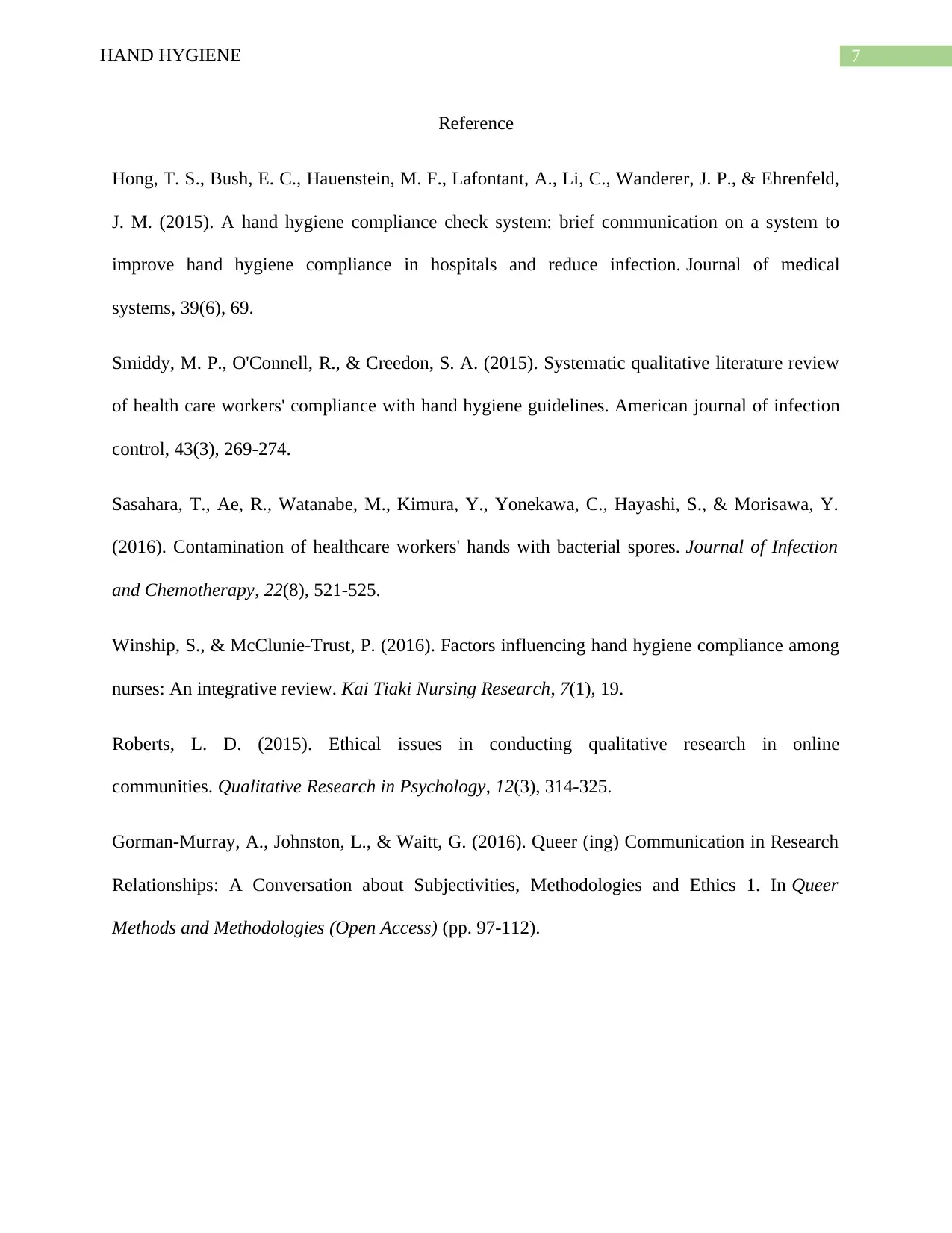
7HAND HYGIENE
Reference
Hong, T. S., Bush, E. C., Hauenstein, M. F., Lafontant, A., Li, C., Wanderer, J. P., & Ehrenfeld,
J. M. (2015). A hand hygiene compliance check system: brief communication on a system to
improve hand hygiene compliance in hospitals and reduce infection. Journal of medical
systems, 39(6), 69.
Smiddy, M. P., O'Connell, R., & Creedon, S. A. (2015). Systematic qualitative literature review
of health care workers' compliance with hand hygiene guidelines. American journal of infection
control, 43(3), 269-274.
Sasahara, T., Ae, R., Watanabe, M., Kimura, Y., Yonekawa, C., Hayashi, S., & Morisawa, Y.
(2016). Contamination of healthcare workers' hands with bacterial spores. Journal of Infection
and Chemotherapy, 22(8), 521-525.
Winship, S., & McClunie-Trust, P. (2016). Factors influencing hand hygiene compliance among
nurses: An integrative review. Kai Tiaki Nursing Research, 7(1), 19.
Roberts, L. D. (2015). Ethical issues in conducting qualitative research in online
communities. Qualitative Research in Psychology, 12(3), 314-325.
Gorman-Murray, A., Johnston, L., & Waitt, G. (2016). Queer (ing) Communication in Research
Relationships: A Conversation about Subjectivities, Methodologies and Ethics 1. In Queer
Methods and Methodologies (Open Access) (pp. 97-112).
Reference
Hong, T. S., Bush, E. C., Hauenstein, M. F., Lafontant, A., Li, C., Wanderer, J. P., & Ehrenfeld,
J. M. (2015). A hand hygiene compliance check system: brief communication on a system to
improve hand hygiene compliance in hospitals and reduce infection. Journal of medical
systems, 39(6), 69.
Smiddy, M. P., O'Connell, R., & Creedon, S. A. (2015). Systematic qualitative literature review
of health care workers' compliance with hand hygiene guidelines. American journal of infection
control, 43(3), 269-274.
Sasahara, T., Ae, R., Watanabe, M., Kimura, Y., Yonekawa, C., Hayashi, S., & Morisawa, Y.
(2016). Contamination of healthcare workers' hands with bacterial spores. Journal of Infection
and Chemotherapy, 22(8), 521-525.
Winship, S., & McClunie-Trust, P. (2016). Factors influencing hand hygiene compliance among
nurses: An integrative review. Kai Tiaki Nursing Research, 7(1), 19.
Roberts, L. D. (2015). Ethical issues in conducting qualitative research in online
communities. Qualitative Research in Psychology, 12(3), 314-325.
Gorman-Murray, A., Johnston, L., & Waitt, G. (2016). Queer (ing) Communication in Research
Relationships: A Conversation about Subjectivities, Methodologies and Ethics 1. In Queer
Methods and Methodologies (Open Access) (pp. 97-112).
1 out of 8
Related Documents
Your All-in-One AI-Powered Toolkit for Academic Success.
+13062052269
info@desklib.com
Available 24*7 on WhatsApp / Email
![[object Object]](/_next/static/media/star-bottom.7253800d.svg)
Unlock your academic potential
© 2024 | Zucol Services PVT LTD | All rights reserved.





